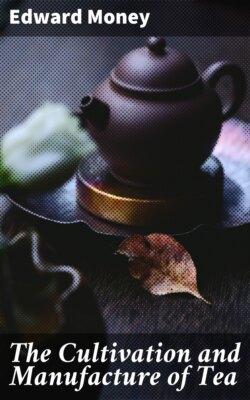Читать книгу The Cultivation and Manufacture of Tea - Edward Money - Страница 7
На сайте Литреса книга снята с продажи.
CHAPTER III.
TEA DISTRICTS AND THEIR COMPARATIVE ADVANTAGES, CLIMATE, SOIL, ETC., IN EACH.
ОглавлениеTable of Contents
The Tea districts in India, that is, where Tea is grown in India to-day, are—[7]
1. Assam.
2. The Dehra Dhoon.
3. Kumaon (Himalayas).
4. Darjeeling (Himalayas).
5. Cachar and Sylhet.[8]
6. Kangra (Himalayas).
7. Hazareebaugh.
8. Chittagong.
9. Terai below Darjeeling.
10. Neilgherries (Madras Hills).
11. Western Dooars.
In fixing on any district to plant Tea in, four things have to be considered—viz., soil, climate, labour, and means of transport. When—the district being selected—a site has to be chosen, all but the second of these have to be considered again, and the lay of land, nature of jungle, water, and sanitation are also of great importance in choosing a site.
I will first, then, discuss generally the Tea districts given above as regards the advantages of each for Tea cultivation. I have seen and studied Tea gardens in all the districts named, except No. 2. What I know of the Dehra Dhoon is from what I have read, and what is generally known of the climate.
Before, however, comparing each district, we should know what are the necessities of the Tea plant as regards climate and soil. Tea, especially the China variety, will grow in very varying climates and soils, but it will not flourish in all of them, and if it does not flourish, and flourish well, it will certainly not pay.
The climate required for Tea is a hot damp one. As a rule, a good Tea climate is not a healthy one. The rainfall should not be less than 80 to 100 inches per annum, and the more of this that falls in the early part of the year the better. Any climate which, though possessing an abundant rainfall, suffers from drought in the early part of the year is not, cæteris paribus, so good as one where the rain is more equally diffused. All the Tea districts would yield better with more rain in February, March, and April; and therefore some, where fogs prevail in the mornings at the early part of the year, are so far benefited.
As any drought is prejudicial to Tea, it stands to reason hot winds must be very bad. These winds argue great aridity, and the Tea plant luxuriates in continual moisture.
The less cold weather experienced where Tea is, the better for the plant. It can stand, and will grow in, great cold (freezing point, and lower in winter, is found in some places where Tea is), but I do not think it will ever be grown to a profit on such sites. That Tea requires a temperate climate was long believed and acted upon by many to their loss. The climate cannot be too hot for Tea if the heat is accompanied with moisture.
Tea grown in temperate climes, such as moderate elevations in the Himalayas, is quite different to the Tea of hot moist climates, such as Eastern Bengal. Some people like it better, and certainly the flavour is more delicate; but it is very much weaker, and the value of Indian Tea (in the present state of the home market, where it is principally used for giving “body” to the washy stuff from China) consists in its strength. Another all-important point in fixing on a climate for Tea is the fact, that apart from the strength the yield is double in hot, moist climes, what it is in comparatively dry and temperate ones. A really pleasant climate to live in cannot be a good one for Tea. I may now discuss the comparative merits of the different Tea districts.
